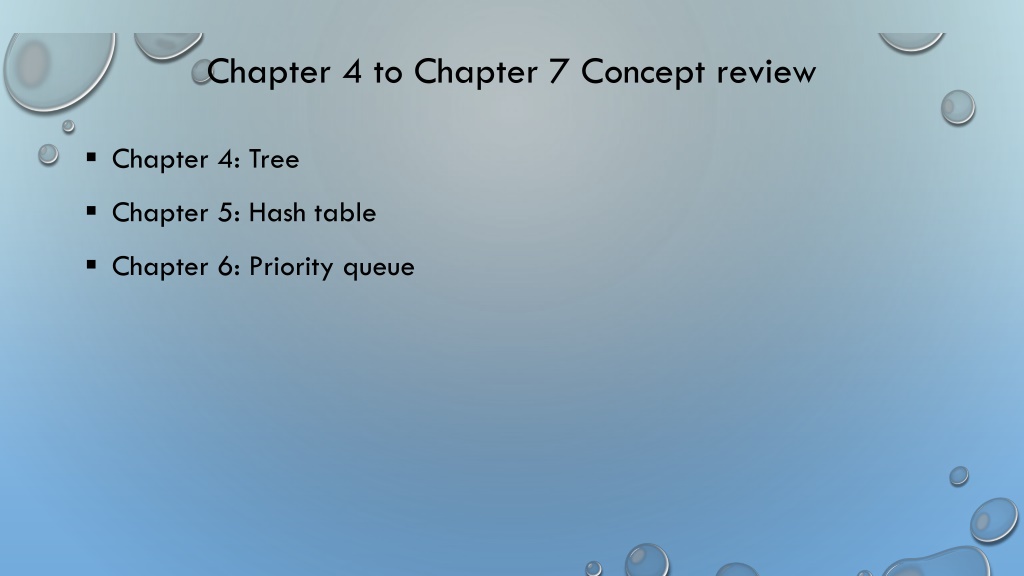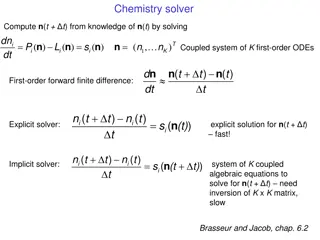
Understanding Tree Concepts and Binary Search Trees
Explore tree concepts including tree structures, traversal methods, and building trees from traversal results. Learn about binary search trees and their properties in this comprehensive review from Chapter 4 to Chapter 7.
Download Presentation

Please find below an Image/Link to download the presentation.
The content on the website is provided AS IS for your information and personal use only. It may not be sold, licensed, or shared on other websites without obtaining consent from the author. If you encounter any issues during the download, it is possible that the publisher has removed the file from their server.
You are allowed to download the files provided on this website for personal or commercial use, subject to the condition that they are used lawfully. All files are the property of their respective owners.
The content on the website is provided AS IS for your information and personal use only. It may not be sold, licensed, or shared on other websites without obtaining consent from the author.
E N D
Presentation Transcript
Chapter 4 to Chapter 7 Concept review Chapter 4: Tree Chapter 5: Hash table Chapter 6: Priority queue
Chapter 4 Tree Concepts: o Tree: A connected graph with no cycle oRooted tree: A connected graph with no cycle and a particular node called root Parent node, child node, sibling nodes, ancestors, descendants, leaf nodes True or false: Some edges in a tree connects sibling nodes? Depth of a vertex Height of a vertex
List the ancestors of J: List the descendent of E: Height and depth of E: Sibling of H: Children of E:
Chapter 4 Tree Concepts: o Recursive definition of a rooted tree o Binary tree o Complete binary tree o Vector representation of a complete binary tree: Root at array[0]: For array[i]: the parent is array[(i-1) / 2], children are array[2*i + 1], and array[2*I + 2] Root at array[1] For array[i]
Draw the binary tree form of the following array representing the complete binary tree A B C D E F G H I J
Tree traversal 1 pre-order: in-order: 2 3 post-order: 5 6 7 8 level-order:
Building tree from tree traversal results True of false: Given any two tree traversal results from pre-order, in-order and post-order traversals, one can uniquely determine the tree. Given pre-order and in-order traversal strings, build the tree. 1. Determine the root (the first node visited in pre-order traversal) 2. Determine the pre-order and in-order strings for the left and right sub-trees in-order substring for the left subtree is the substring before the root. Let the number of letters be X. pre-order substring for the left subtree is the substring after the root with X items. in-order substring for the right subtree? Pre-order substring for the right subtree is? 3. Recursively build the left and right sub-trees. What is the string for post-order traversal of the tree with o string for pre-order traversal: ABCDEFG o string for in-order traversal: CBDEAFG
Binary search tree Definition: A binary tree B is called a binary search tree iff: o There is an order relation < defined for the vertices of B o For any vertex v, and any descendant u of v.left, u < v o For any vertex v, and any descendent w of v.right, v < w Binary search tree is also known as Totally Ordered Tree Describe how to perform search, insert, and remove on a binary search tree. Build the binary search tree by inserting the following numbers into an empty binary search tree: 100, 50, 60, 55, 200, 150, 160, 30, 52 After the tree is built, remove 60, 50, 100
AVL tree AVL tree definition: AVL tree is binary search tree with the balance condition: for every node in tree, height of left and right subtree can differ by at most 1. An AVL tree is maintained by fixing the node(s) that violate the balance condition after each insertion and deletion. oThe fixing is done through single or double rotation. oFor insert, the fixing only needs to be performed at the lowest level node that violates the condition. How to find that node to be fixed in insertion?
AVL tree How to find that node to be fixed in insertion? o Check from the parent of the newly inserted node upward to the root. The first node that violates the condition is the node to be fixed (and this is the only node that needs fix). Depending on the position of the inserted node with respect to the node to be fixed, there are four cases: oLeft of the left children of the node to be fixed (case 1, single rotation) oRight of the left (case 2, double rotation) oLeft of the right (case 3, double rotation) oRight of the right (case 4)
Single rotation Case 1: new data inserted to X Case 2: new data inserted to Z
Double rotation Case 3: new data inserted to B or C or just k2 Case 4: new data Inserted to B or C or k2
Building AVL tree Draw the AVL tree after each of the following numbers is inserted: 100, 50, 60, 55, 52, 40, 30
B-tree: definition B-Tree is an M-ary search tree with the following balancing restrictions 1. 2. Data items are stored at the leaves Non-leaf nodes store up to M-1 keys to guide the searching: keys are sorted within a node, Key i represents the smallest key in subtree (i+1). The root can either be a leaf, or have between 2 to M children All non-leaf nodes except the root have between ceil(M/2) and M children All leaves are at the same depth and have between ceil(L/2) and L data items, for some L. 3. 4. 5. Key points: All leaves are in the same level. Each node except the root is at least half full. o o
Populate the missing keys in the B-tree For each node, the k-th key is the smallest value in the k+1 th sub-tree 2 4 7 8 12 14 17 18 32 35 37 39 40 45 46 47 48 50 52 54 56 58 60 63 64 65 70 72 73 78 80 81 83 85 92 94 95 98 99 104 106 107 108 112 114 117 118 119 122 124 127 128
B-tree search IF ???? < ???0 THEN GO TO ???????0 IF ???? ?????????? THEN GO TO ??????????????+1 ELSE ???? ???? < ????+1 THEN GO TO ????????+1 TRY SEARCH 40, 58, 94, 71. 16
B-tree insert (insert 57, 40) DO A SEARCH TO FIND THE LEAF NODE TO INSERT THE DATA INSERT THE DATA INTO THE LEAF IF THERE IS SPACE. OTHERWISE, SPLIT THE LEAF INTO TWO (WHICH RESULTS IN ONE MORE ENTRY IN ITS PARENT NODE, THIS IN TURN MAY RESULT IN PARENT NODE TO SPLIT) 17
B-tree delete (delete 99) DO A SEARCH TO FIND THE LEAF NODE TO DELETE THE DATA AND DELETE THE DATA. ? 2DATA ENTRIES, THEN DONE. IF THE LEAF STILL HAS AT LEAST OTHERWISE, MERGE WITH DATA IN NEIGHBORING LEAF TO MAKE ? 2DATA ENTRIES SURE THAT EACH LEAF STILL HAS AT LEAST 18
Chapter 5: Hash table Big idea: To approximate a giant table indexed by the key Two key issues: hash function and resolving conflicts Hash function o Evenly map the keys into an integer o The design of hash function is somewhat beyond CS Resolving conflicts o Chaining with separate lists o Probing open address
Chaining with separate lists Hash table is a vector of lists. Conflicts are resolved with the list: multiple items can be stored in one list How to do search, insert, and remove on such a table? Let Hash(x) = x % 10; search 68, 70; insert 23, 45; remove 64
Chaining with separate lists How to achieve the average O(1) complexity with this? o load factor
Chaining with separate lists, build the table Let the hash table has 7 entries, Hash(x) = x % 7 How does the table look after: 10, 7, 9, 3, 16, 20 are inserted?
Probing Open Address The table contains an array of elements If collision occurs, try another cell to look. o try cells h0(x), h1(x), h2(x), h3(x) in succession until a free cell is found. hi(x) = hash(x) + f(i)and f(0) = 0 o Linear probling: f(i) = i; try hash(x), hash(x) + 1, hash(x)+2 o Describe how to do search, insert, and remove with linear probing o Let the hash table size be 10, Hash(x) = x % 10 o How does the table look after: 10, 19, 9, 3, 22, 20 are inserted assuming no rehashing?
Probing Open Address The table contains an array of elements If collision occurs, try another cell to look. otry cells h0(x), h1(x), h2(x), h3(x) in succession until a free cell is found. hi(x) = hash(x) + f(i)and f(0) = 0 oQuadratic probing: f(i) = ?2; try hash(x), hash(x) + 1, hash(x)+4, hash(x) + 9, o Double hashing: f(i) = i*hash2(x)
Probing Open Address How to make sure that insert, search, and remove have the average O(1) complexity? True or False: The worse case time complexity for search in a hash table is O(N).
Chapter 6: priority queue Heap concept: o A partially ordered tree (POT) is a tree T such that: There is an order relation <= defined for the vertices of T For any vertex p and any child c of p, p <= c o Partially ordered complete binary tree Allowing vector representation of the tree
Vector representation of the tree Storing the tree in level order continuously May start from index 0 or index 1 o Different starting index affects the tree navigation (how to compute parent and children nodes) o Starting from index 1: parent of v[k] is ? left child of v[k] is?, right child of v[k] is? o What if the index starts from 0?
Heap operations DeleteMIN: the heap size decreases by 1 o Move the last element to root and percolate down from the root. How to percolate down? Insert o Put the new element at the end of the vector o fix the heap towards to root.
Building heap Inserting items one by one resulting in O(N log N) heap building algorithms A better O(N) heap building algorithm builds the heap from bottom up by percolate elements backward (from N/2 to 1). oLogically, this heap building algorithm operates by dumping the original data into the heap and then fixing the heap from bottom up (from the last node to the first node)! o Build the heap: 100 80 60 90 10 1 70 40
Building heap and heap operations Using the O(N) algorithm to build the heap for the following items: 30 20 60 70 10 7 100 After the heap is built, insert 1, 32, 50 to the heap After the insertions, do deleteMIN two times, show the heap after each deleteMIN.













